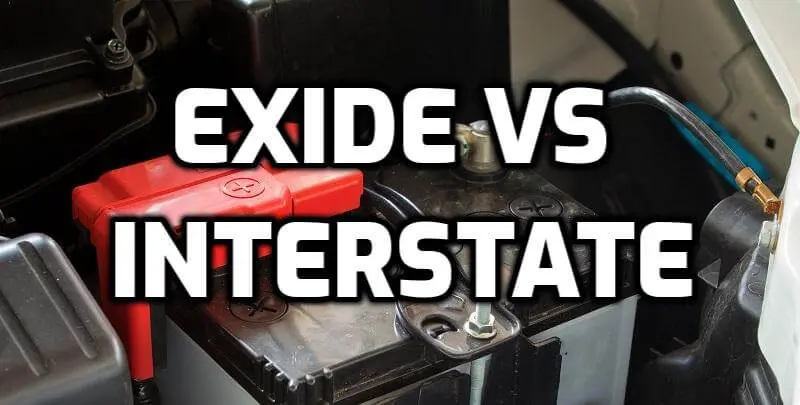Interstate Vs Exide Car Battery

If you need help deciding which car battery brand to choose, Exide Orbital or Interstate, this blog post will provide a comparison of the two and help make your decision easier. Both are reputed brands with their own advantages and disadvantages. Get informed now so that you can buy wisely!
Interstate Vs Exide Battery Table
This comparison table will help provide precisely what you need for your vehicle to be outfitted with top of line parts.
Exide | Interstate |
Model is Exide Orbital | Model is Interstate MTZ-34R |
Absorbent Glass Mat Battery | Absorbent Glass Mat Battery |
Dimension is 9.06 X 7 X 8 Inches | Dimension is 10.82 X 6.76 X 7.84 Inches |
Battery Group Size 48 | Battery Group Size 34R |
Battery Voltage is 12 | Battery Voltage is 12 |
40 Month Manufacturer Warranty From Date Of Purchase | 48 Month Free Replacement Warranty |
Provides 80 Minutes Of Reserve Capacity | Provides 125 Minutes Of Reserve Capacity |
Negative Terminal Location Top Left And Positive Terminal Location Top Right | Positive Terminal On The Right Side And A Negative Terminal On The Left Side |
750 Cold Cranking Amps | Cold Cranking Amps 800 |
Weight Is Around 40.78 Lbs | Weight Is Around 46.6 LBS |
Provide Cushioning For Better Vibration Resistance | Plenty Of Power For Accessories And Plug-ins |
Non Spill Able And Can Be Mounted Upright | Has Mounting Flexibility And Provides More Cranking Power |
Vibration Resistant And Can Be Operates In Any Position | Has Mounting Flexibility And Provides More Cranking Power |
Why Compare?
There are a few key reasons you should compare Exide orbital batteries and Interstate batteries. You may be unsure which brand is the best for your needs, or you’re just curious about the differences between the two brands.
No matter what your reason may be, we hope that this blog post will help you make a decision about which battery is correct for you. Exide orbital batteries are known for their durability and longevity. In contrast, Interstate MTZ batteries are known for their high performance and fast charging.
Battery Types
AGM batteries are known for their high performance and fast charging, making them an excellent choice for vehicles that need a lot of power. If you’re looking for a battery that can handle a lot of energy, then an AGM battery is the right choice. Both Exide orbital and Interstate MTZ offer AGM batteries, so you can choose the brand that best meets your needs.
Reserve Capacity
One key difference between Exide orbital and Interstate batteries is their reserve capacity. Reserve capacity measures the amount of time a battery can maintain 25% of its rated capacity. This is an essential measure of battery performance, as it indicates how long the battery will last in a crisis. Exide orbital has a Reserve capacity of 80 Minutes, and Interstate MTZ Provides 125 Minutes of Reserve Capacity.
The Reserve Capacity of an Interstate MTZ battery is typically higher than that of an Exide orbital battery. This means that Interstate MTZ batteries are better for vehicles that need a lot of power, such as trucks or RVs. If you’re looking for a high-reserve capacity battery, you should choose an Interstate MTZ battery.
Cold Cranking Amperage
Another critical difference between Exide orbital and Interstate batteries is their Cold Cranking Amperage. Cold Cranking Amperage (CCA) measures a battery’s ability to start a vehicle in cold weather. The higher the CCA rating, the better the battery will start a vehicle in cold weather. Exide orbital batteries have a CCA of 750, while Interstate MTZ batteries have a CCA of 800.
Voltage
When choosing a new car battery, the battery’s voltage is also necessary to consider. The voltage of a battery determines the amount of power it can deliver. Exide orbital batteries have a voltage of 12 volts, while Interstate MTZ batteries have a voltage of 12.24 volts.
Group Size
The battery’s group size is also important to consider when choosing a new car battery. The group size of a battery determines the physical dimensions of the battery. Exide orbital batteries have a group size of 48, while Interstate MTZ batteries have a group size of 34R.
The physical dimensions of an Interstate MTZ battery are typically smaller than those of an Exide orbital battery. This makes Interstate MTZ batteries a good choice for vehicles with limited space. If you’re looking for a small group-size battery, you should choose an Interstate MTZ battery.
Warranty
Finally, the warranty is essential to consider when choosing a new car battery. Exide orbital batteries have a 40-month Manufacturer’s Warranty from the Date of Purchase. In contrast, Interstate MTZ batteries have a warranty of 48 months.
The more extended the warranty, the better the battery will be protected against defects and problems. If you’re looking for a battery with an extended warranty, you should choose an Interstate MTZ battery.
Dimensions LxWxH
The dimensions of the battery are also essential to consider when choosing a new car battery. The dimensions of the battery determine how much space it will take up in your vehicle. Exide orbital batteries have dimensions of 9.06 x 7 x 8 inches, while Interstate MTZ batteries have dimensions of 10.82 x 6.76 x 7.84 inches.
The dimensions of an Interstate MTZ battery are typically larger than those of an Exide orbital battery. This means that Interstate MTZ batteries are a good choice for vehicles with a lot of space. If you’re looking for a battery with large dimensions, you should choose an Interstate MTZ battery.
Terminal Location
The positive terminal location of a battery is also essential to consider when choosing a new car battery. The positive terminal location of a battery determines where the positive terminal is located on the battery. Exide orbital batteries have a positive terminal location on Top-Right. In contrast, Interstate MTZ batteries have a Positive Terminal on the Right Side and a Negative Terminal on the Left Side.
Our Observation
The main difference between Exide and Interstate Car Battery is reserve capacity. Exide orbital has a reserve capacity of 80 minutes, while Interstate MTZ provides 125 minutes of reserve capacity. The observations we made while researching these two types of batteries were that Interstate MTZ batteries are typically better for vehicles that need a lot of power.
They also have a higher CCA, voltage, and extended warranty when compared to Exide orbital batteries. However, Exide orbital batteries are a good choice for vehicles with limited space because they have a smaller group size. If you’re looking for a battery with large dimensions, then you should choose an Interstate MTZ battery.
Conclusion
When choosing a new car battery, it’s essential to consider the battery’s capacity, the cold cranking amperage, the voltage, the group size, the warranty, and the dimensions of the battery. I hope you found this guide helpful. Please feel free to ask in the comments section below if you have any questions. Thank you for reading!
Related Article

Mark Takahashi, Car parts guru with a passion for mechanics. Blogger extraordinaire, translating auto jargon into everyday magic. Drive into his world of knowledge!


